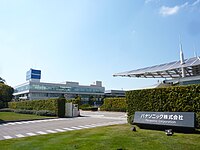
Photo from wikipedia
Abstract Provision of high-quality care and ensuring retention of children on antiretroviral therapy (ART) are essential to reduce human immunodeficiency virus (HIV)-associated morbidity and mortality. Virological non-suppression (≥1000 viral copies/ml)… Click to show full abstract
Abstract Provision of high-quality care and ensuring retention of children on antiretroviral therapy (ART) are essential to reduce human immunodeficiency virus (HIV)-associated morbidity and mortality. Virological non-suppression (≥1000 viral copies/ml) is an indication of suboptimal HIV care and support. This retrospective cohort study included ART-naïve children who initiated first-line ART between July 2015 and August 2017 in Johannesburg and rural Mopani district. Of 2739 children started on ART, 29.5% (807/2739) were lost to care at the point of analysis in August 2018. Among retained children, overall virological non-suppression was 30.2% (469/1554). Virological non-suppression was associated with higher loss to care 30.3% (229/755) compared with suppressed children (9.7%, 136/1399, P < 0.001). Receiving treatment in Mopani was associated with virological non-suppression in children under 5 years (adjusted odds ratio (aOR) 1.7 (95% confidence interval (CI) 1.1–2.4), 5–9 years (aOR 1.8 (1.1–3.0)) and 10–14 years (aOR 1.9 (1.2–2.8)). Virological non-suppression was associated with lower CD4 count in children 5–9 years (aOR 2.1 (1.1–4.1)) and 10–14 years (aOR 2.1 (1.2–3.8)). Additional factors included a shorter time on ART (<5 years aOR 1.8–3.7 (1.3–8.2)), and male gender (5–9 years, aOR1.5 (1.01–2.3)), and receiving cotrimoxazole prophylaxis (10–14 years aOR 2.0 (1.2–3.6)). In conclusion, virological non-suppression is a factor of subsequent programme loss in both regions, and factors affecting the quality of care need to be addressed to achieve the third UNAIDS 90 in paediatric HIV.
Journal Title: Epidemiology and Infection
Year Published: 2021
Link to full text (if available)
Share on Social Media: Sign Up to like & get
recommendations!